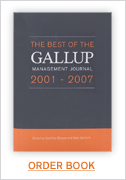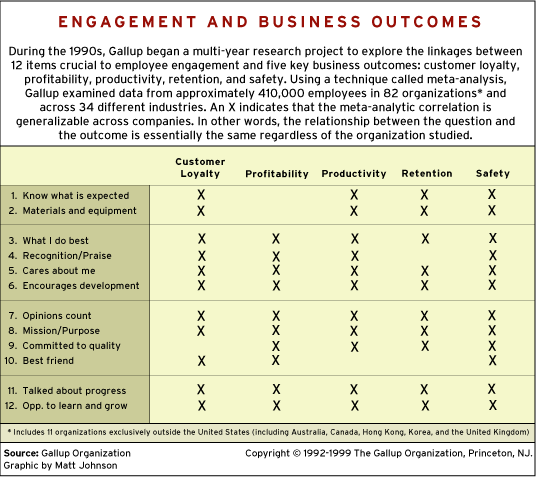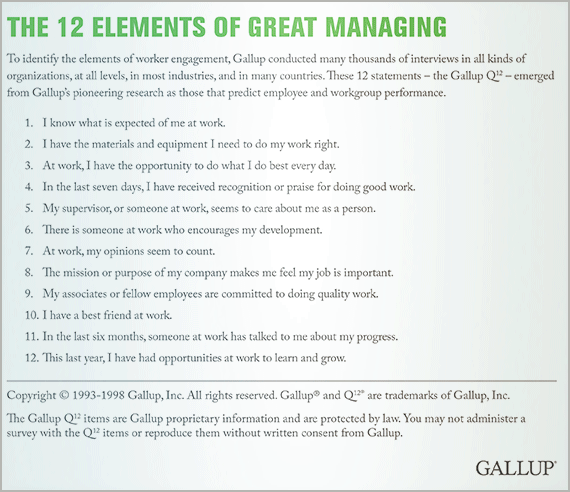Is Gallup anti-competencies? At a surface level, the answer appears to be yes. A few of the organization's thought leaders have publicly railed against competency programs. And the Gallup Management Journal has published articles that are highly critical of competencies. (For example, see "Incompetencies" in the "See Also" area on this page.)
 |
In light of this, I decided to investigate this subject in more depth, and I uncovered surprising results. As you might have expected, Gallup's top researchers and management experts have experienced frustration with bad competency programs. Many of the programs they encounter force employees to spend the most time in the areas where they have the least natural talent. And very few competency programs are truly performance-based. One expert went as far as to say, "I am not against them, but I do think 90% are misguided. Over the last 10 years, I have seen great competency programs, and they work. But they are rare."
Across the board, people I interviewed were against bad competencies, not all competencies. If a competency is, by definition, something proven to drive performance that can be developed, then Gallup is actually a heavy user of competencies. When you look deeper into Gallup using this definition, you see:
- managers who are held accountable for increasing employee engagement based on 12 core competencies
- executives who are expected to improve on seven basic "demands" of leadership
- employees who are rated on, and expected to meet, key client service competencies
With the exception of the label itself, competencies are pervasive at Gallup. So why have we frowned on this widely embraced management concept? One big reason is the wide variation within competency programs.
Most competency programs are struggling. They start with the best intentions, then veer off course as they evolve. Companies begin with a few, strong "core competencies" that quickly turn into a laundry list of vaguely defined and immeasurable items. Employees who are expected to become everything on this wish list suffer as a result. The outcome is dysfunction, and performance can decline. As one Gallup expert puts it, "Competency programs can turn into remedial programs in no time."
That being said, several organizations have rock-solid competency programs in place. Their programs engage employees and fuel financial growth. What are they doing differently? These organizations follow two simple rules that can keep any competency program on track.
If you can't prove it, don't use it.
Defining the right competencies is everything. If you use your intuition alone, the program will fail. But if you ground competencies in sound science, the programs will pave the road for growth.
For example, if you have a hunch that managers in your organization need to "set clear expectations" for their employees, put this to the test. The best way to test a competency is to conduct the research within your own organization. Survey as many employees as you can, asking them if their managers set clear expectations. Then compare the data you collect to real performance metrics -- customer engagement or retention, or better yet, employee productivity. If you find a significant correlation between managers setting clear expectations and performance on the job, you have found a solid competency. If no significant relationship exists, don't use it.
Collecting these data can be a challenge, but it's usually worth the effort. If this is not possible, look to external sources for validation. Remember, organizations have very different goals, values, and missions. So make sure any outside data you rely on is based on a cross-section that includes several comparable organizations. At Gallup, we have tested 12 employee engagement items across a wide range of industries and workgroups. (See graphics "Engagement and Business Outcomes" and "The 12 Elements of Great Managing.") As you can see, these items have been proven to drive concrete business outcomes and can serve as essential competencies for a manager.
 |
Teach what's teachable.
By definition, competency programs aim to identify areas that can be improved with training and other developmental activities. This makes it easy to get started, as virtually anything can be learned to some extent. But herein lies the trap:
- It is relatively easy to acquire knowledge -- whom you should ask when you have accounting questions, how to access your voicemail and e-mail systems, or how to find the latest press releases from your clients.
- Similarly, it may take more time, but it is also possible to acquire new skills -- the ability to perform the basic steps of creating formulas in Microsoft Excel, cooking a hamburger at a fast food restaurant, or ensuring compliance with government regulations.
- However, in sharp contrast, natural talents are more stable over time -- the ability to be more competitive, to display empathy, or the rare capacity to be very social and "work a room."
If you want your competency program to produce results as quickly as possible, the key is to start by identifying each person's unique talents, because talents provide a strong foundation for growth. Imagine a building. The stronger and more stable the foundation, the taller the building can become. It's much the same for people. When building on a strong talent base, it's possible to achieve more in less time.
Returning to the example of managers who are held accountable for "setting clear expectations," let's see how this plays out. If a manager is naturally very empathetic, help her set expectations for her employees by leveraging her ability to listen. She can use her talent to help employees define not only what they need to do, but how they can accomplish it. If you have another manager who has talents for being very disciplined and analytical, allow him to set expectations by creating smart and detailed written plans for each employee.
The next step is to augment the manager's talents with the right knowledge and skills. The manager needs to know the company's goals and policies (knowledge) to set the right expectations. She might also need the basic skills required to enter each employee's review into a Web-based performance management and review system. Once managers learn these steps, they will have even more capacity for rapid growth.
 |
The key is to leverage talents as the multiplier. Organizations with great competency programs not only allow each person to find his or her own route to reaching a desired competency -- they encourage employees to start with their natural talents. This makes the journey more enjoyable for the individual and opens the door for exponential progress.
Simply put, the most effective way to make a competency program work is to set measurable outcomes, then let people's talents lead the way.
